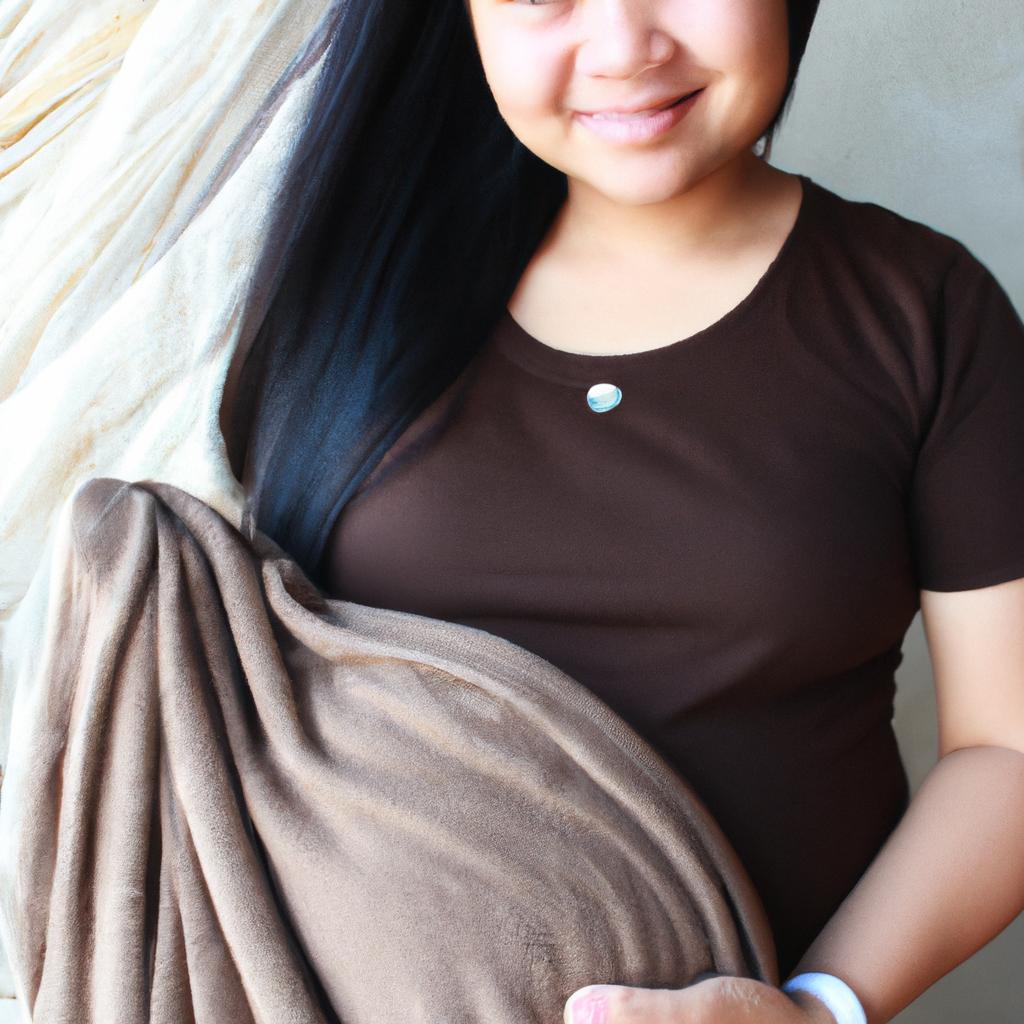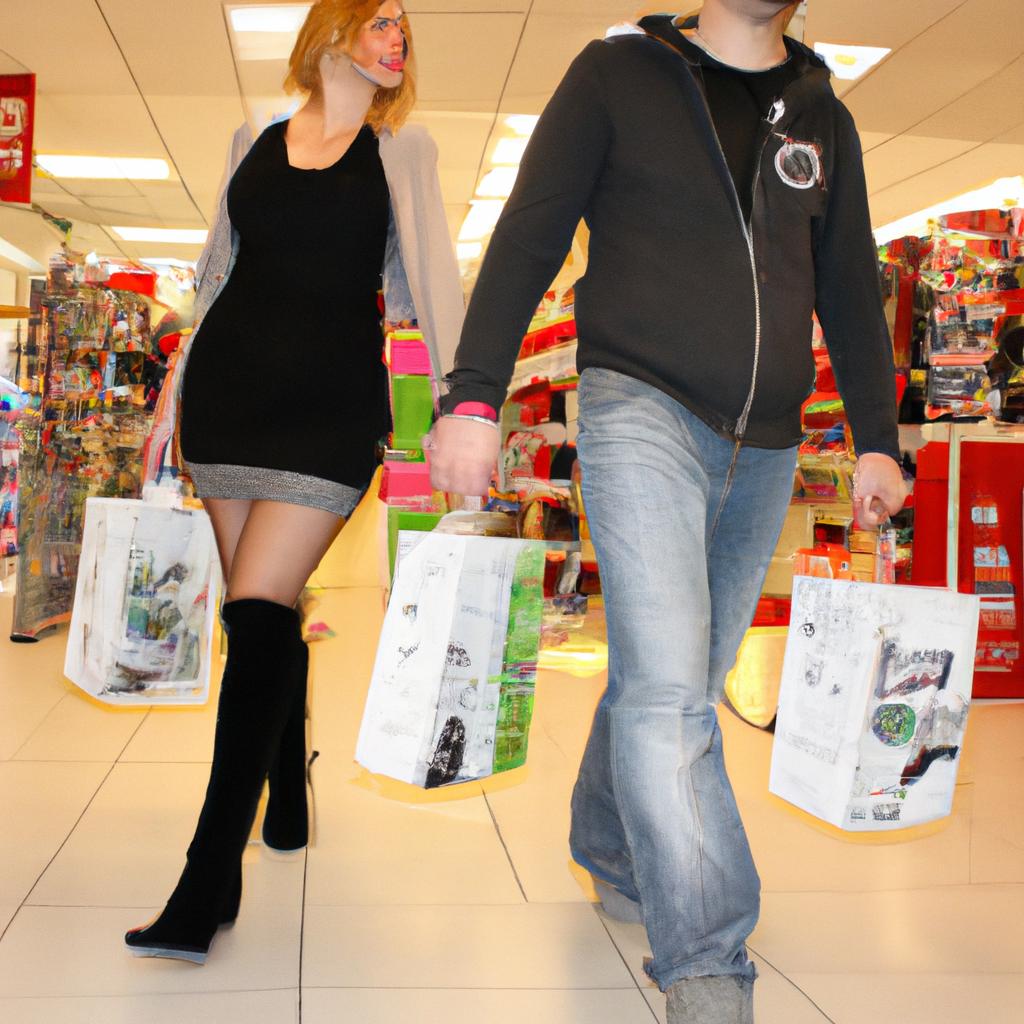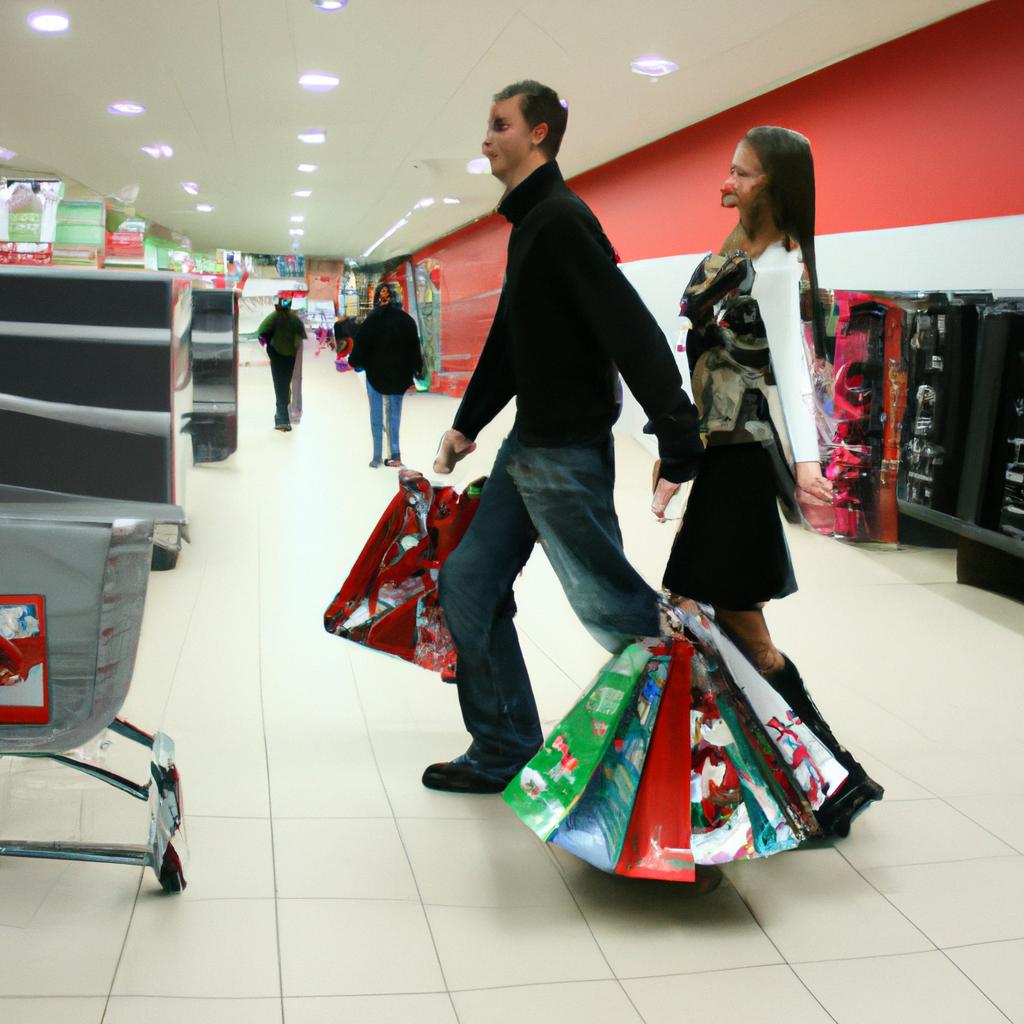Every parent wants their baby to be comfortable, stylish, and well-dressed. However, achieving the perfect baby outfit can sometimes be a daunting task. The key to success lies not only in choosing the right clothes but also in selecting the appropriate accessories that complement them. For instance, imagine a scenario where a new mother has carefully selected an adorable onesie for her baby girl. However, without the proper accessories like socks or hats, the outfit lacks the finishing touch it needs to truly stand out.
In this article, we will explore the importance of baby accessories and how they contribute to overall style and comfort. We will delve into various types of essential items such as socks, hats, bibs, and headbands that every parent should consider when dressing their little one. By understanding why these accessories are crucial and how they enhance both practicality and aesthetics, parents can ensure their babies always look chic while remaining cozy throughout the day. So let’s dive into the world of baby accessories and discover the secrets behind achieving ultimate success in dressing our precious bundles of joy.
Choosing the Right Size
Imagine this scenario: Sarah, a new mother, excitedly opens a package containing an adorable onesie for her baby. However, to her disappointment, when she tries to put it on her little one, she realizes that it is too small. Frustrated and unsure of what went wrong, Sarah finds herself in need of some guidance in choosing the right size for her baby’s clothes.
To avoid similar situations, it is crucial for parents to understand how to select appropriate clothing sizes for their babies. This section will provide valuable insights into making informed decisions regarding sizing.
Firstly, it is essential to recognize that every baby grows at their own pace. As such, relying solely on age labels may not always be accurate. Instead, consider measuring your baby’s height and weight regularly as they grow. By doing so, you can refer to size charts provided by manufacturers or retailers and choose clothing items that align with your child’s measurements.
When selecting sizes for your baby’s clothes, keep the following points in mind:
- Babies tend to outgrow their clothes quickly during the first few months.
- Opt for slightly larger sizes if you anticipate rapid growth or want the item to last longer.
- Ensure there is ample room around the neck area and armholes without being too loose or tight.
- Pay attention to closures (buttons, snaps) and ensure they are easy to fasten and unfasten.
| Size | Age Range (Months) | Height Range (inches) | Weight Range (lbs) |
|---|---|---|---|
| Newborn | 0-1 | Up to 21 | Up to 8 |
| 3M | 2-3 | 22–24 | 9–12 |
| 6M | 4-6 | 25–27 | 13–16 |
| 9M | 7-9 | 28–29 | 17–20 |
In conclusion, choosing the right size for your baby’s clothes requires careful consideration. By measuring your baby’s height and weight regularly and referring to size charts provided by manufacturers or retailers, you can ensure a better fit and avoid unnecessary frustrations.
Moving on to the next section, we will explore the importance of selecting comfortable and safe fabrics for your baby’s clothing.
Comfortable and Safe Fabrics
Choosing the right size for your baby’s clothes is crucial to ensure their comfort and ease of movement. In the previous section, we discussed various factors to consider when selecting the appropriate size. Now, let us delve deeper into understanding why this aspect holds such significance.
Imagine a scenario where you purchase an adorable onesie for your little one that appears to be the perfect fit based on its labeled size. However, upon trying it on, you realize that it is too tight around your baby’s arms and legs, restricting their movements and causing discomfort. On the other hand, if the garment is too loose, it can lead to potential safety hazards such as entanglement or tripping.
To avoid these issues, here are some key points to keep in mind when choosing the right size for your baby’s clothing:
- Consider growth spurts: Babies grow at a rapid pace during their first year of life. Opting for clothes with adjustable features like elastic waistbands or expandable necklines can accommodate these growth spurts.
- Take measurements: Use a soft measuring tape to accurately measure your baby’s height, weight, chest circumference, and inseam length. Referencing these measurements against standard sizing charts can help you determine the most suitable sizes for different brands.
- Prioritize comfort: Look for clothes made from soft and breathable fabrics that won’t irritate your baby’s delicate skin. Additionally, opt for designs that allow easy access for diaper changes or dressing purposes.
- Read customer reviews: Before making a purchase online or in-store, take some time to read reviews from other parents who have bought similar items. Their experiences can provide valuable insights into whether certain brands tend to run small or large.
To further illustrate the importance of choosing the right size effectively, let us consider the following case study:
| Child | Age | Clothing Size | Issue |
|---|---|---|---|
| Emma | 6 mo | 3-6 months | Clothes too tight, causing discomfort during playtime |
In this case, Emma’s parents initially bought her clothes labeled for the right age range. However, they failed to consider their baby’s specific measurements and growth rate. Consequently, the clothing items purchased were too constricting for Emma, hindering her ability to freely move and explore her surroundings.
By taking into account factors such as growth spurts and comfort preferences, you can ensure that your little one is dressed in appropriately sized garments that promote ease of movement and overall well-being.
Transitioning into our next section on “Comfortable and Safe Fabrics,” we will explore the importance of selecting fabrics that prioritize your baby’s comfort while also ensuring their safety throughout different weather conditions and activities.
Essential Clothing Pieces
Having explored the importance of comfortable and safe fabrics in baby clothing, let us now delve into essential clothing pieces that form the foundation of a well-rounded baby wardrobe.
To ensure optimal comfort and functionality for your little one, there are several key clothing items to consider:
-
Bodysuits: Also known as onesies or rompers, bodysuits are versatile garments that provide coverage from neck to toe. They feature snaps at the crotch area for easy diaper changes and are typically made from soft cotton fabric. With their ability to keep diapers in place and prevent them from bunching up under other layers, bodysuits serve as a practical base layer for any outfit.
-
Sleepsacks: Designed with safety in mind, sleepsacks offer a cozy alternative to blankets while reducing the risk of suffocation during sleep. These wearable blankets come in various sizes and weights suitable for different seasons, ensuring your baby stays warm without overheating. The zipper closure allows for easy access when changing diapers during nighttime routines.
-
Pants with Elastic Waistbands: As babies grow rapidly, it is crucial to have pants with elastic waistbands in their wardrobe. This design ensures a comfortable fit while accommodating their ever-changing size. Additionally, pants with reinforced knees can withstand crawling adventures without wearing out quickly.
-
Soft Hats: Protecting your baby’s delicate head from both cold weather and harsh sunlight is essential. Opt for soft hats made from breathable materials like organic cotton or bamboo fabric that will not irritate their sensitive skin. Look for designs with chin straps or adjustable closures to secure the hat in place during outdoor activities.
Evoke an emotional response through bullet points:
- Ensuring your baby’s comfort throughout the day
- Promoting hassle-free dressing and undressing
- Creating a sense of security and protection
- Simplifying daily care routines
Evoke an emotional response through table format (markdown):
| Clothing Item | Features | Benefits |
|---|---|---|
| Bodysuits | Snaps for easy diaper changes | Keeps diapers in place |
| Sleepsacks | Wearable blanket alternative | Reduces suffocation risk during sleep |
| Pants | Elastic waistbands, reinforced knees | Accommodates growth and crawling movements |
| Soft Hats | Breathable materials, adjustable closures | Protects delicate head from weather elements |
Incorporating these essential clothing pieces into your baby’s wardrobe not only ensures their comfort but also simplifies the daily care routine. Dressing and undressing become hassle-free tasks while promoting a sense of security and protection.
Moving forward to functional and stylish accessories that can enhance both the practicality and aesthetics of your little one’s outfits…
Functional and Stylish Accessories
Now that we have explored the essential clothing pieces for your baby, let’s move on to discussing functional and stylish accessories. These accessories not only enhance your baby’s overall look but also serve practical purposes in ensuring their comfort and well-being.
Imagine this scenario: You are taking a walk with your little one on a sunny day. To protect them from harmful UV rays, you reach into your bag and pull out a cute sun hat designed specifically for babies. Not only does it add an adorable touch to their outfit, but it also shields their delicate skin from the harsh sunlight. This example demonstrates how functional accessories can provide both style and protection.
To further illustrate the significance of these accessories, here is a list of four must-have items every parent should consider:
- Soft and absorbent bibs to keep your baby clean during mealtime.
- Cozy mittens or socks to keep those tiny fingers and toes warm.
- Adorable headbands or hair clips for adding a fashionable twist to any outfit.
- Practical diaper bags with multiple compartments to ensure all essentials are within easy reach.
In addition to the above examples, another way to showcase the importance of functional accessories is through visual representation. Consider this table outlining various accessories along with their benefits:
| Accessory | Benefit |
|---|---|
| Baby sunglasses | Protecting sensitive eyes from bright sun |
| Reversible hats | Versatile options for different outfits |
| Teething necklaces | Soothing teething discomfort |
| Bandana drool bibs | Absorbing excessive saliva |
By incorporating these functional and stylish accessories into your baby’s wardrobe, you can elevate their outfits while providing practical solutions. Whether it’s protecting them from environmental elements or making everyday tasks easier, these accessories play a crucial role in enhancing both style and functionality.
As we continue our exploration of creating a successful baby clothes collection, the next section will delve into another vital aspect: proper storage and organization. By implementing effective strategies, you can ensure that your little one’s clothes are easily accessible and well-maintained. So let’s move forward and discover how to efficiently store and organize your baby’s clothing items.
Proper Storage and Organization
Section 2: Proper Storage and Organization
Imagine a scenario where a new parent, let’s call her Sarah, has just purchased a set of adorable baby clothes for her newborn. As she begins to unpack the boxes, she realizes that she needs an efficient way to store and organize these tiny garments. In this section, we will explore the importance of proper storage and organization for baby clothes.
To begin with, having a well-organized system can save parents valuable time and energy when it comes to dressing their little ones. By implementing smart storage solutions, such as labeled bins or hanging organizers, parents can easily locate specific items without rummaging through piles of clothing. For instance, Sarah could use clear plastic containers with dividers to separate different sizes or types of clothing like onesies, sleepers, and socks. This not only simplifies the process but also helps extend the lifespan of each garment by minimizing wear and tear caused by unnecessary handling.
Moreover, an organized approach ensures that no outfit is overlooked or forgotten in the depths of drawers or closets. When baby clothes are neatly arranged, parents have better visibility of what they already own and can avoid duplicate purchases. An appealing option is using drawer dividers or fabric cubes within dressers to keep smaller items visible yet contained. Additionally, hanging organizers provide extra space for accessories like hats or mittens while keeping them easily accessible.
- Reduces stress associated with searching for specific outfits.
- Maximizes closet/drawer space utilization.
- Facilitates easy rotation between different sizes as the baby grows.
- Preserves sentimental value by preventing damage through clutter.
Let us now delve into how these benefits can be realized more effectively through a visual representation – a table showcasing various storage options along with their advantages:
| Storage Option | Advantages |
|---|---|
| Clear plastic bins | Easy visibility and categorization |
| Hanging organizers | Accessible storage for accessories |
| Drawer dividers | Organization within drawers |
| Fabric cubes | Efficient use of dresser space |
By incorporating these storage solutions, parents can create an environment that is both functional and aesthetically pleasing. This not only streamlines the process of dressing their baby but also ensures that every item has its place, preventing misplacement or damage.
Transitioning into the subsequent section about “Tips for Long-lasting Baby Clothes,” it is important to note how proper storage and organization directly contribute to prolonging the lifespan of these garments. By implementing effective strategies in this area, parents can take a proactive approach towards ensuring the longevity of their baby’s clothing investment.
Tips for Long-lasting Baby Clothes
Moving on from proper storage and organization, let us now explore some valuable tips for ensuring the longevity of your baby’s clothes.
Example: Imagine this scenario – you have carefully folded and stored away your baby’s adorable onesies and tiny socks, only to discover that they are already too small when you take them out again. To avoid such disappointments, here are some practical suggestions:
-
Size up wisely: Babies grow at an astonishing rate, so it is essential to consider purchasing clothes in slightly larger sizes. This will allow your little one to wear them comfortably for a longer duration before outgrowing them.
-
Opt for durable materials: When selecting baby clothes, prioritize fabrics that can withstand multiple washes without losing their quality or shape. Choose options like cotton blends or organic textiles known for their durability and resistance to wear and tear.
-
Reinforce high-impact areas: Certain parts of baby clothes tend to experience more friction or strain during everyday activities. Reinforcing these areas with patches or extra stitching can greatly extend the lifespan of garments, saving you the trouble of frequent replacements.
-
Embrace versatility: Look for clothing items that offer flexibility in terms of styling and functionality. For instance, opt for pants with adjustable waistbands or convertible rompers that can be transformed into shorts as your baby grows taller.
- Cherish precious memories by preserving favorite outfits.
- Reduce waste by passing down well-maintained baby clothes to future siblings or friends.
- Save money by investing in long-lasting pieces that do not require constant replacement.
- Contribute to sustainable practices by minimizing textile consumption through careful maintenance.
Emotional Table:
| Item | Benefit | Responsibility |
|---|---|---|
| Proper care | Preserves sentimental value | Ensuring garments’ longevity |
| Passing down | Fosters connections between family members | Promoting sustainable clothing practices |
| Financial savings | Allows for more budget-friendly options in the long run | Reduces overall consumption and waste |
| Environmental | Contributes to reducing textile waste and promoting | Supports a greener future by minimizing resource usage |
Incorporating these tips into your baby’s wardrobe management routine will not only help you save time, money, and effort but also allow you to create lasting memories with their adorable outfits. By making conscious choices that prioritize durability and sustainability, you can ensure that your little one’s clothes remain intact throughout their early years. So, go ahead and embrace these strategies to make the most of your baby’s wardrobe!
(Note: In conclusion or Finally)




